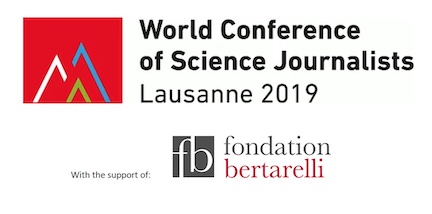
The organisers of the 2019 World Conference of Science Journalists, WCSJ2019 have announced the fourteen winners of a competition to find the best scientific journalism stemming from the conference. Ten winners each receive a Bertarelli Foundation Media Grant to attend the next WCSJ in Medellin, Colombia, in 2022. Four additional winners, coming from French-speaking countries, receive a similar grant in the framework of the WCSJ2019 efforts to support science journalism in the “Francophonie”.
WCSJ2019 was held in Lausanne from 1-5 July 2019 and organised by the science journalists’ associations of Switzerland, ASJS, France, AJSPI, and Italy, SWIM, with the support of the World Federation of Science Journalists, WFSJ. The conference attracted over 1300 science journalists, writers and communicators from 83 countries. To build on this success, and to secure continuity through to the next WCSJ in Medellin, one of WCSJ2019’s main supporters, the Bertarelli Foundation, generously agreed to fund the Media Competition, which was proposed by the WCSJ2019 organisers.
The competition was open to all WCSJ2019 participants whose main area of activity is science journalism. Entrants were asked to send in up to two articles or media contributions they had produced based on a topic or an idea originating at the conference whether from a conference session, a field trip, a lunch@lab gathering, an exhibit, or indeed anything inspired by WCSJ2019. By the deadline of 31 December 2019, the organisers had received 51 entries, from 31 participants. Entries were evaluated by a jury according to predetermined criteria to assess aspects including, amongst others, their originality, style, journalistic method, quality and format. The jury was composed of Hélène Le Meur (science journalist, Programme committee member responsible for Keynote speakers), James Gillies (science communicator at CERN and co-head of the WCSJ2019 Communication team), Christine d’Anna-Huber (Secretary General of the Swiss Association of Science Journalism, Executive director of the WCSJ2019 Organising committee) and Olivier Dessibourg (President 2012-2019 of the Swiss Association of Science Journalism and Chairman of the Board of the WCSJ2019 Organising committee).
Five prizes consisting a full grant to attend WCSJ2022, covering travel, hotel nights, conference fee, and a per diem, were originally foreseen. Thanks to a positive balance at the end of the WCSJ2019, the organisers are now happy to announce that there will 10 winners of this Bertarelli Foundation Media Grant.
Their name (in alphabetical order) and their contributions are: • DE VRIEZE Jop, “Reflections of a science journalist: is an overview study just an opinion?”
• IRWIN Aisling, “The Everything Mapper”
• LACHOWSKI Caroline, “Comment développer le journalisme scientifique en Afrique?”
• PALMER Jane, “The chemists policing Earth’s atmosphere for rogue pollution”
• PONCHNER Debbie, “Trans Ovaries and the Privilege of Growing Old”
• POWELL Kendall, “What electronic games can teach us”
• POZNIAK Helena, “Refugees and technology: on a journey of self-discovery”
• ROMAN Valeria, “Transgender in Latin America: Unfolded from Otherness”
• SHETTY Disha, “65% Indians Exposed To Heatwaves”
• SIMON Laurent, “On a passé la semaine dans un endroit formidable”
Since one of the strands of WCSJ2019 was to promote quality science journalism in the French-speaking world – la Francophonie (document in French) – a further four grants are being made to French-speaking journalists. Their names and contributions are, in alphabetical order:
- • BALAO Kossi Elom, « Miser sur la science, c’est miser sur le futur, c’est miser sur l’avenir d’une société »
- • FRAMMERY Catherine, « La science n’est pas un discours équilibré! »
- • HOUNGNIGBE Isaac, «Magazine Radio Foire WCSJ2019 »
- • VERNET Agnès, « J’ai trié des terrains de baseball… et compris pourquoi l’IA ne remplacera pas les journalistes »
The WCSJ2019 Organising committee and the Bertarelli Foundation warmly congratulate the winners of this competition and thank all the participants for their submissions.
The WCSJ2019, which brought science journalists, acclaimed scientists, along with high-level decision-makers, politicians and policy makers to Lausanne, attracted worldwide media coverage. Many of the sessions were recorded on video and are freely available. The Organising Committee produced a full Final report, published in January 2020, describing the event.